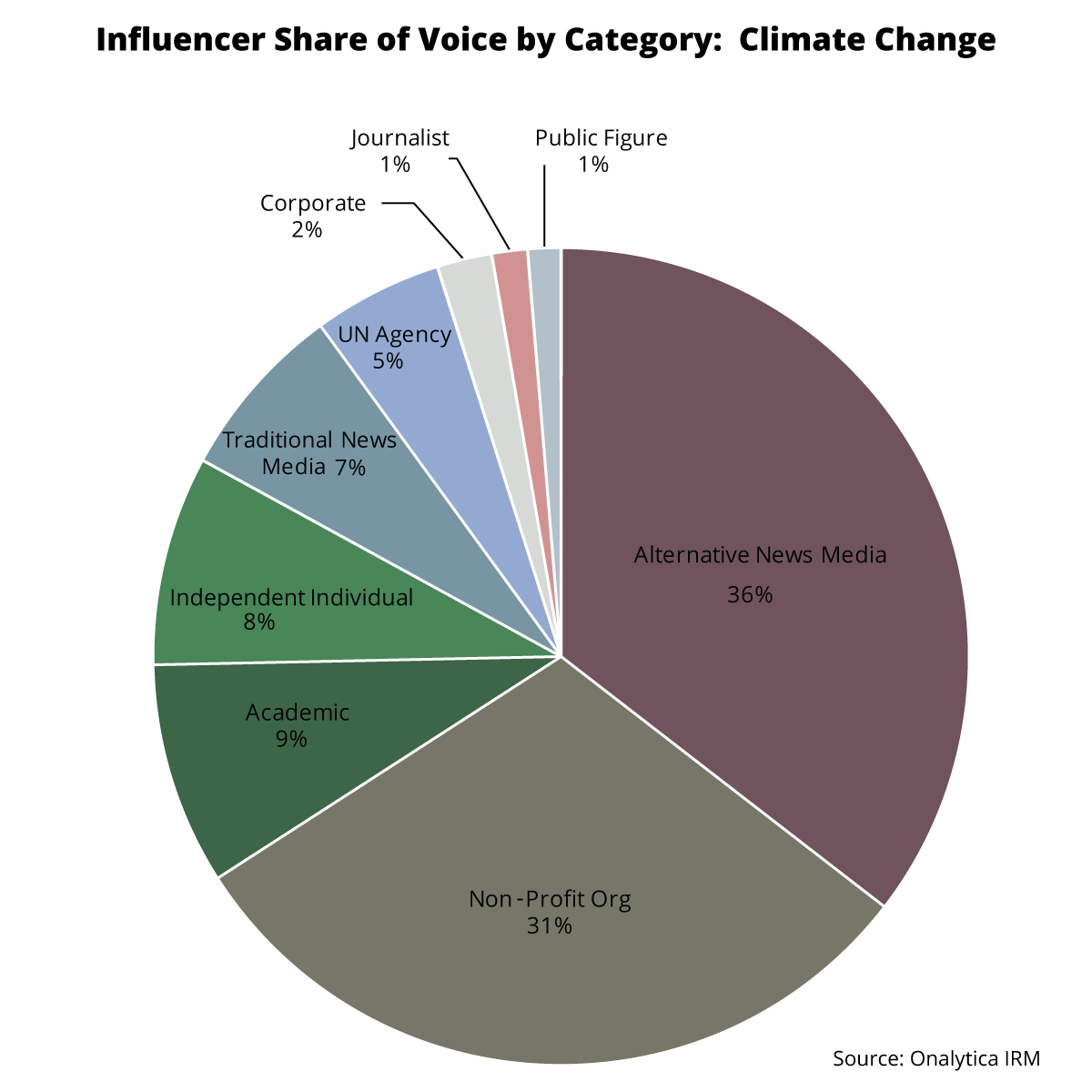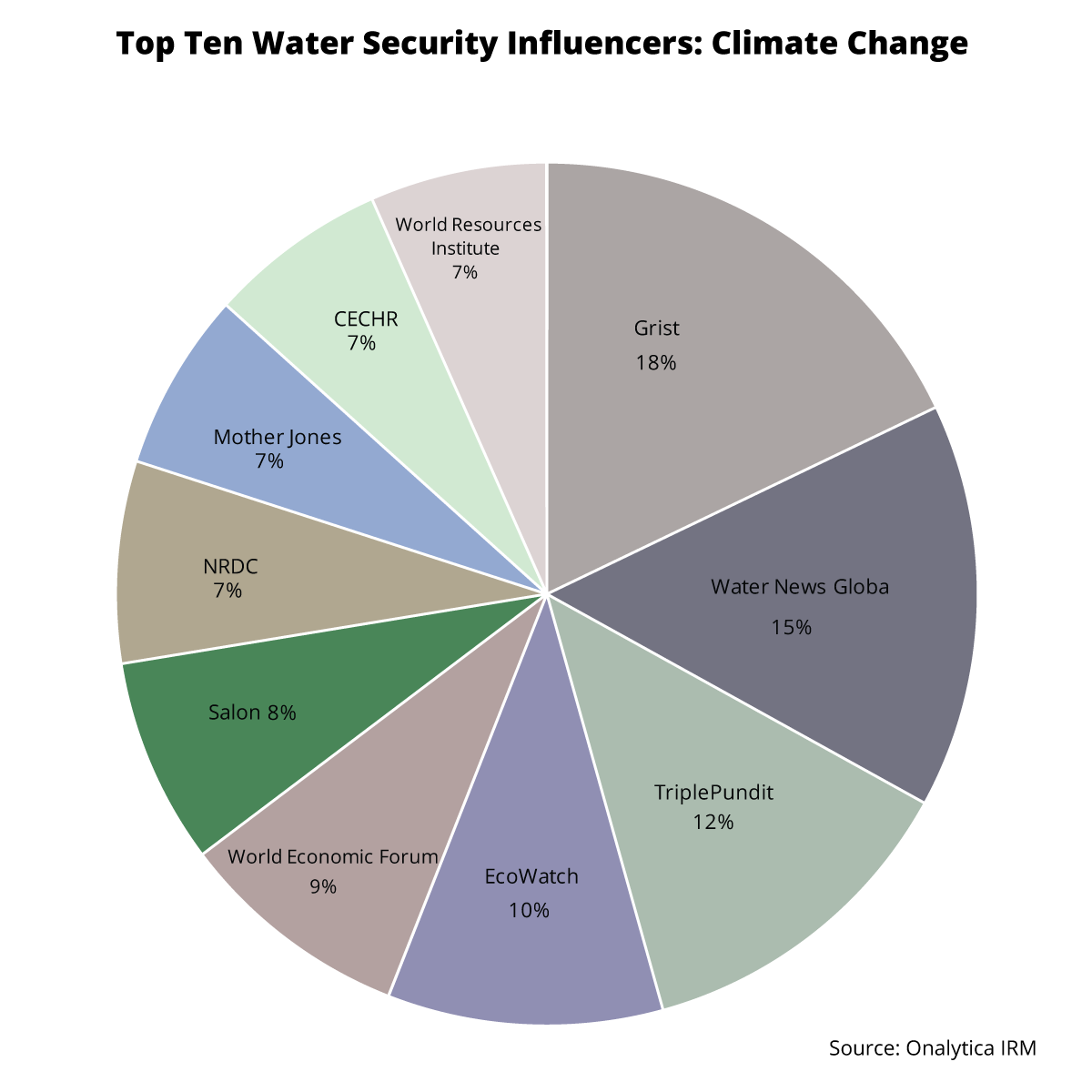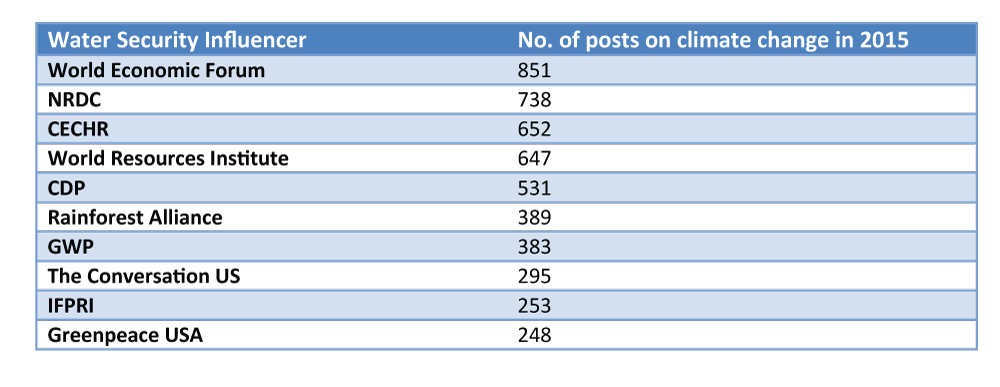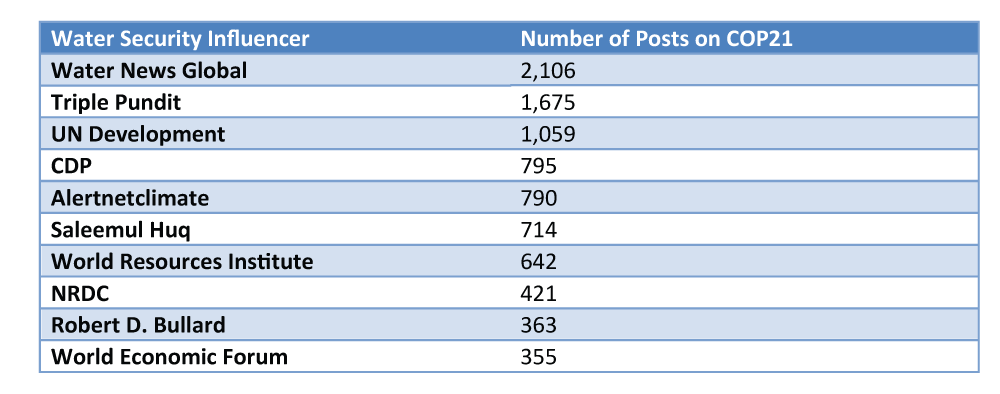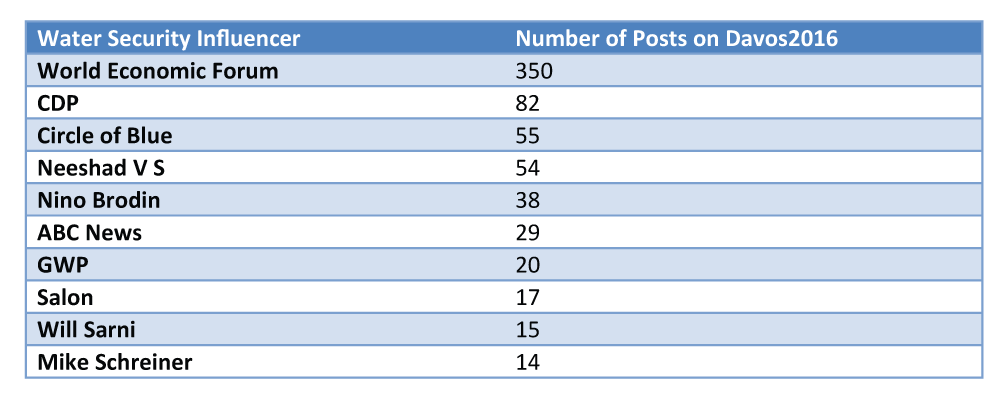At Onalytica we identified the key climate change influencers when we produced the Climate Change: Top 100 Influencers and Brands report in December 2015. Water security and climate change are inextricably linked however, and many of our Water Security Influencers: Top Individuals and Brands were clearly engaged on the subject of climate change in the context of water security. We wanted to share some of the key insights we discovered in our analysis of the top Water Security Influencers and how they deliberated on climate change in 2015.
KEY INSIGHTS
- Climate change was the largest debate driver out of all water security subjects, with Water Security Influencers mentioning climate change in 23,519 posts in 2015;
- Influencers categorised as ‘alternative news media’ led discussions, experiencing the highest volume of posts on climate change in 2015;
- Non-profit organisations also showed high digital activity on the subject of climate change, responsible for 31% of influencer posts on climate change;
- Of the almost 7,000 climate change posts by non-profit organisations, 73% could be attributed to ten influential brands;
- Individuals played an important role in posting about climate change in 2015, with six influential academics playing notable roles in the discussion;
- COP21 received significantly more attention among influencers than Davos2016.
Who is talking about climate change?
Water Security Influencers discussed climate change in 23,519 posts in 2015, making this subject the largest debate driver out of all water security-related topics in our analysis.
We attributed different category tags to our Water Security Influencers: Top Individuals and Brands. The above chart shows the relative share of voice of the different categories of influencers discussing climate change in 2015.
The top Water Security Influencers discussing climate change were largely alternative news media sources*, with 7,924 posts on the subject in 2015. Non-profit organisations followed with 6,793 posts. Academics and independent individuals played an important role in spreading discussions on the subject of climate change, making 1,965 and 1,854 posts on the topic, respectively. The complete breakdown of the post counts can be found below:
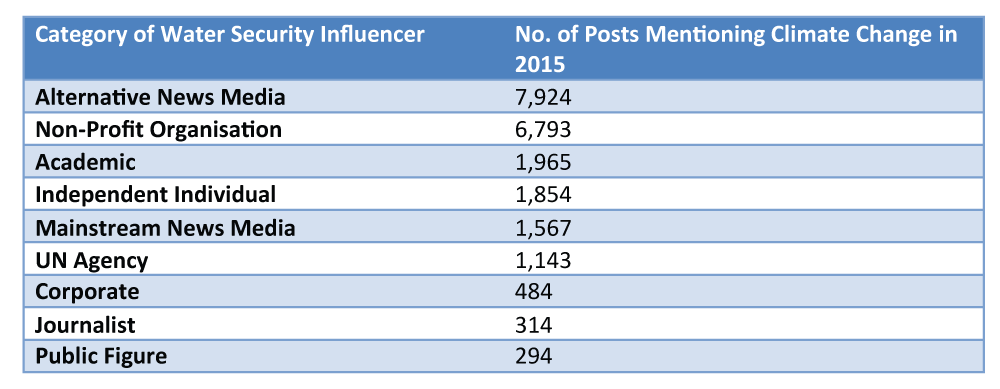
*How did we classify our news media? By ‘alternative news media’ we are referring to publications that fall outside the category of local and mainstream online newspapers. Alternative news media includes other online publications such as: Weekly newsletters; Digital-only publications; Subject-specific news media (environmental news, water news, etc.); and Non-profit or independently-funded news outlets.
Which of the Water Security Influencers were the most vocal about climate change?
Our analysis shows that the top ten most engaged Water Security Influencers discussing climate change were the following players:
The above chart shows the relative share of voice of the top ten Water Security Influencers: Individuals and Brands discussing climate change in 2015.
All of the top ten Water Security Influencers posting about climate change were brands; no individual water influencers penetrated the top ten list. Six alternative news media sources (Grist, Water News Global, Triple Pundit, EcoWatch, Salon, and Mother Jones) were responsible for over 70% of the share of voice of the top ten influencers posting about climate change. Together they made 6,866 posts on the subject in 2015. Non-profit organisations also played an important role in influencer discussions on climate change. The World Economic Forum was the leading non-profit Water Security Influencer posting about climate change, with 851 posts on the subject in 2015. Together, non-profit organisations (the World Economic Forum, NRDC, CECHR, and World Resources Institute) absorbed 29.6% of the share of voice of Water Security Influencers discussing climate change, making a total of 2,888 posts on the subject in 2015. 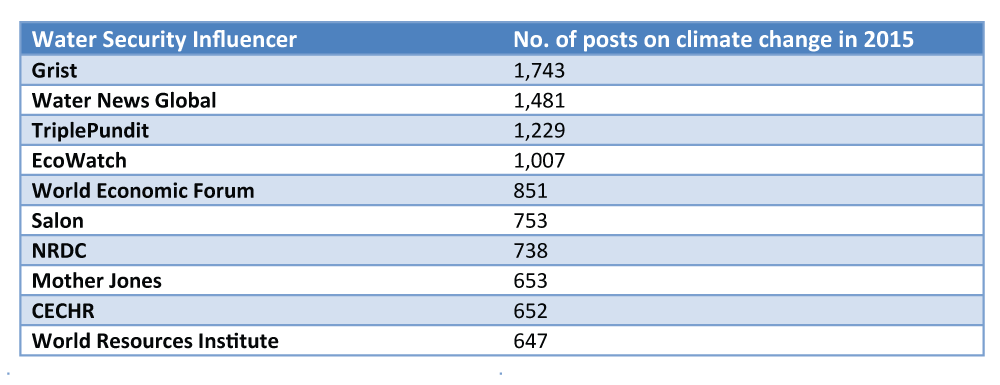
Which non-profit Water Security Influencers were the most vocal on the topic of climate change?
Although non-profit organisations had a smaller share of voice than alternative news media outlets on the topic of climate change, non-profit organisations nonetheless demonstrated significant interest in the subject, sharing 6,793 posts on climate change in 2015. We analysed this sub-category to determine which non-profit influencers showed the most digital activity on the topic of climate change. 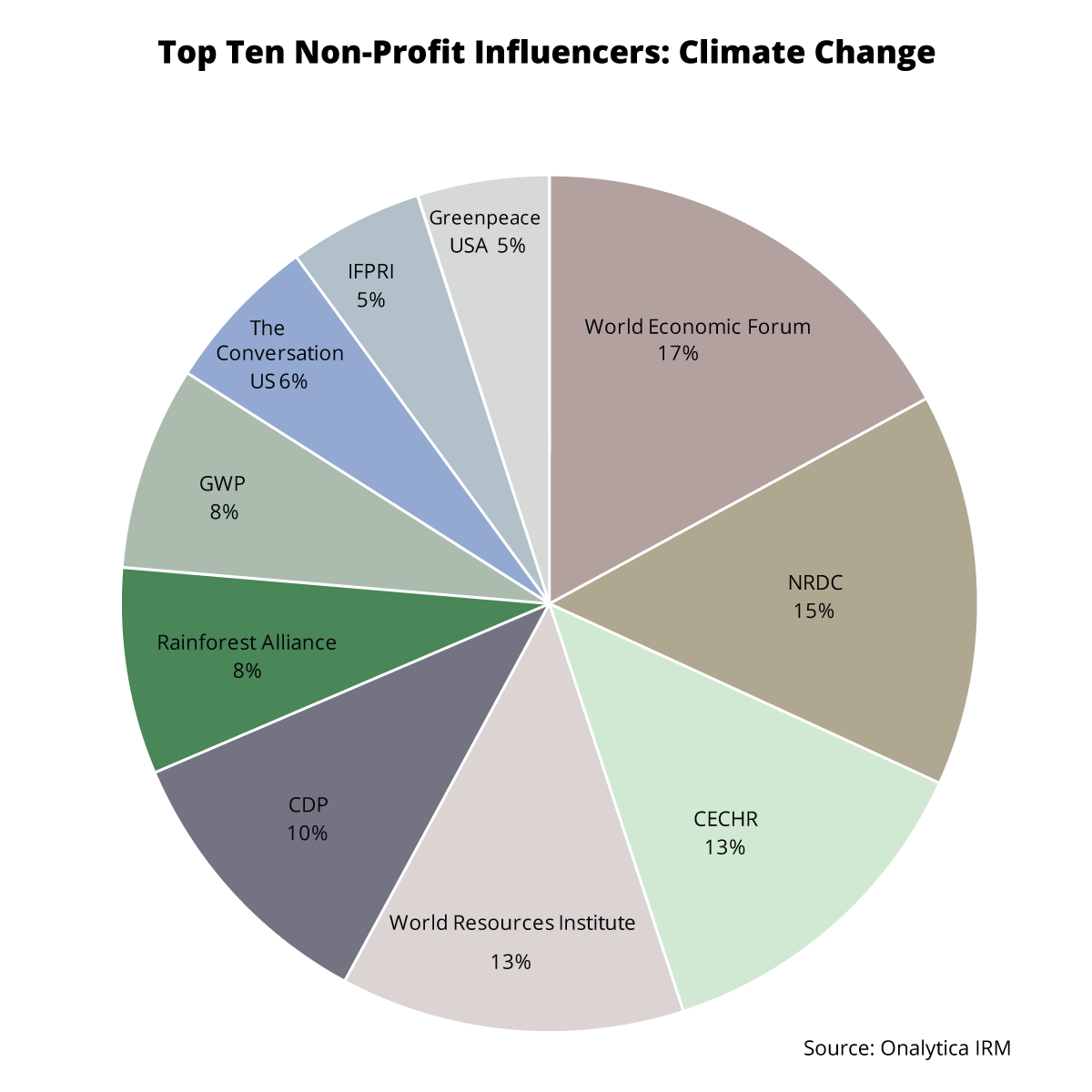
The above chart shows the relative share of voice of the top ten Water Security Influencers categorised as non-profit organisations, which were discussing climate change in 2015.
Non-profit organisations were responsible for 31% of all Water Security Influencer tweets on climate change, sharing 4,987 posts on the subject in 2015. The World Economic Forum, NRDC, CECHR and the World Resources Institute all stood out at the top of the list, being the only non-profits to penetrate the overall top ten Water Security Influencers on climate change. However the remaining top ten non-profit influencers discussing climate change (CDP, Rainforest Alliance, GWP, The Conversation US, IFPRI, and Greenpeace USA) also made an important impact on the conversation, together mentioning climate change in 2,099 posts in 2015. The complete breakdown of post volumes by top non-profit organisations may be found below:
Which individual Water Security Influencers were the most vocal on the subject of climate change?
Although independent individuals from our list of Water Security Influencers did not make the top ten influencers communicating about climate change, they were nonetheless highly influential on the subject. Together influential journalists, academics, independent individuals, and public figures all joined the conversation on climate change, collectively making 4,427 posts on the subject in 2015. Indeed, 57% of those posts were generated solely by ten highly influential people: 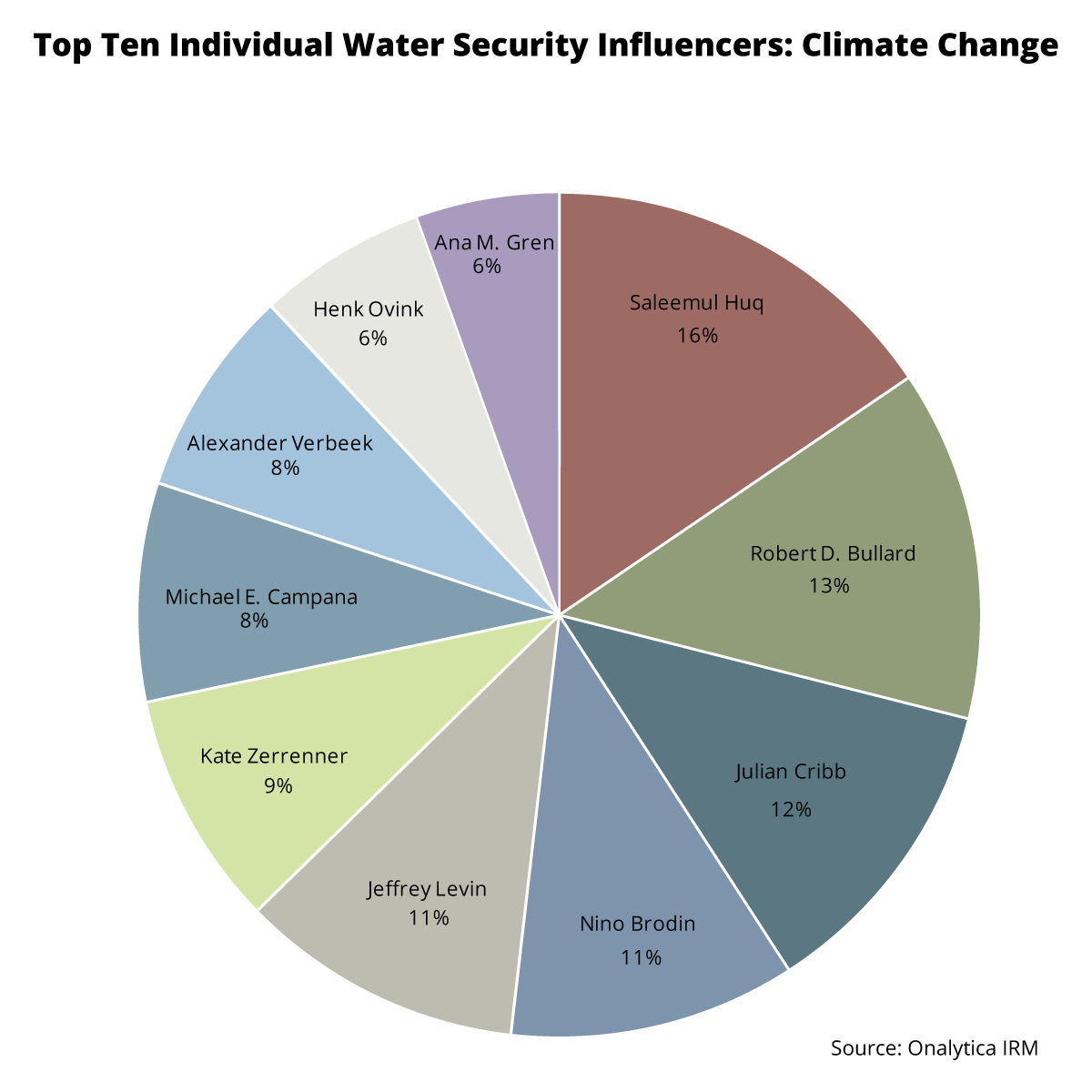
The above chart shows the relative share of voice of the top ten individual Water Security Influencers discussing climate change in 2015.
The top ten individual Water Security Influencers posted about climate change in 2,504 posts in 2015. When compared with all the Water Security Influencers together, posts by these ten individuals accounted for 11% of the more than 23,500 climate change posts by Water Security Influencers in 2015. Analysis of the top ten individual Water Security Influencers shows that the most vocal people on the subject are likely to be academics. Saleemul Huq, Robert D. Bullard, Julian Cribb, Nino Brodin, Michael E. Campana, and Alexander Verbeek collectively discussed climate change in 1,708 posts in 2015, accounting for 68.2% of the share of voice of the top ten individual influencers on climate change. The remaining individual influencers on the top ten list were independent individuals. Jeffrey Levin, Marketing Programs Manager at Unite Blue, EDF Manager Kate Zerrenner, and public servants Henk Ovink (Netherlands) and Ana M. Gren (Sweden) collectively mentioned climate change in 796 posts in 2015. 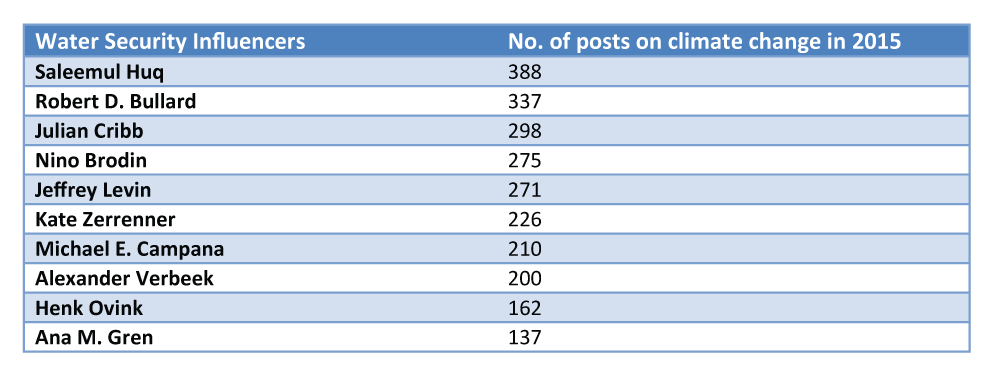
How much did water influencers engage on COP21 and Davos2016?
At Onalytica we predicted that the two major international conferences would result in a surge of influencer activity at the approach of each meeting, given that climate change was expected to be a key topic at each event. However while influencer activity did increase prior to each event, water influencers showed considerably more engagement on COP21 than they did on Davos 2016. 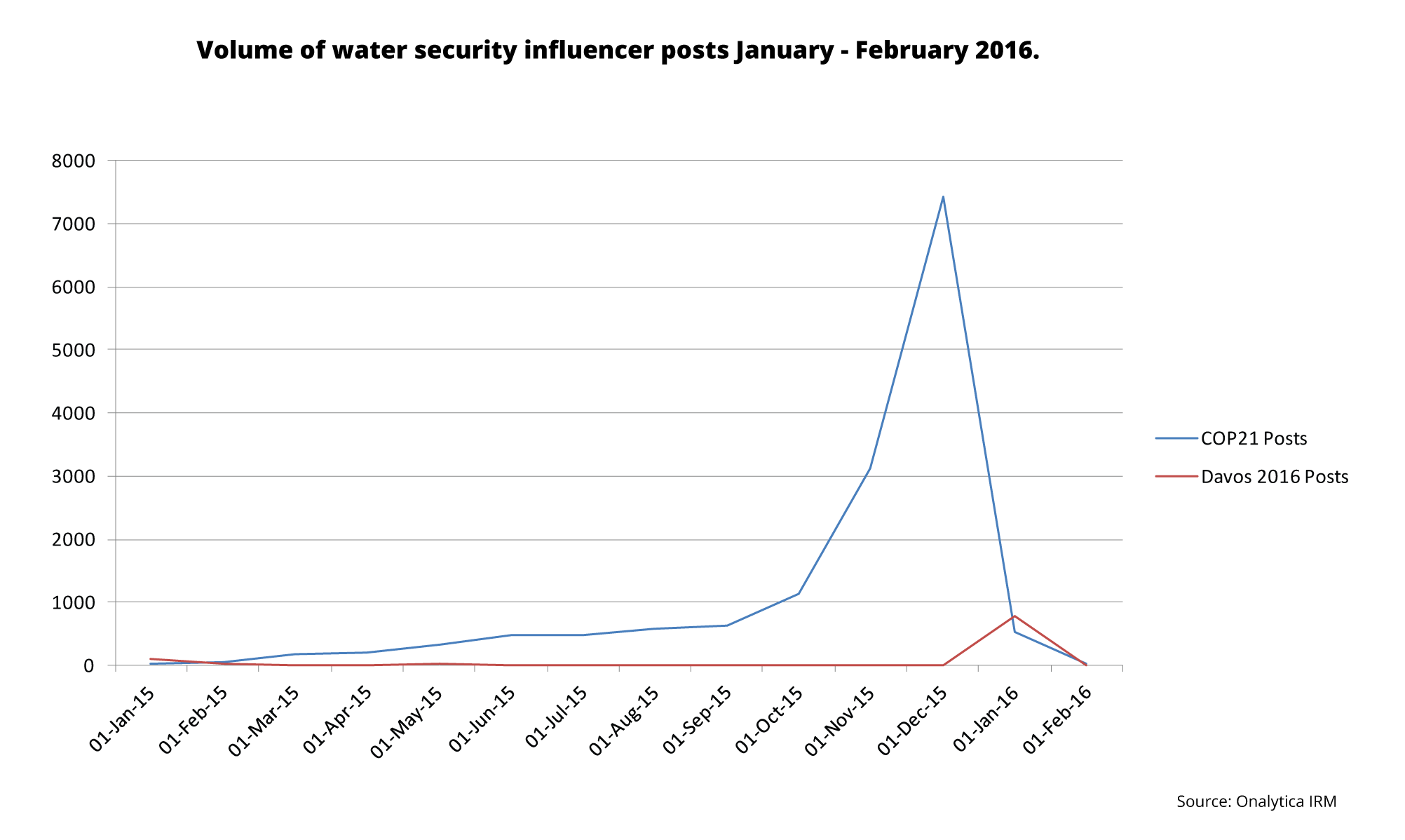
The above chart shows the volume of Water Security Influencer posts between January 1, 2015 to February 1, 2016.
Interestingly, despite the World Economic Forum’s obvious commitment to climate change – evidenced by the organisation placing as the top Water Security Influencer posting about climate change – influencers posted significantly less frequently about Davos2016 than they did about COP21. Analysis shows that during the peak of COP21 coverage in December 2015, water influencers made 7,477 posts mentioning the event. In contrast, influencers only mentioned Davos 2016 in 800 posts during peak coverage in January 2016.
The top influencer on the COP21 event was Water News Global, while the top influencer on Davos 2016 was the World Economic Forum. The only Water Security Influencers to be found in the top ten lists for both events were the World Economic Forum and CDP.
What have we learned from this data?
With 23,519 posts on climate change, Water Security Influencers of various backgrounds joined in the discussion to push forward advocacy and thought leadership on the topic.
- Alternative news media led the quantity of communications on climate change in 2015, followed by non-profit organisations.
- Six alternative news media sources (Grist, Water News Global, Triple Pundit, EcoWatch, Salon, and Mother Jones) were responsible for the greatest share of voice of the top ten influencers posting about climate change.
- Non-profit organisations also showed high engagement on the subject, with the World Economic Forum, NRDC, CECHR and the World Resources Institute standing out as top non-profit Water Security Influencers posting about climate change.
- Individual influencers played an important role in the conversation on climate change also, with the top ten individual Water Security Influencers posting about climate change accounting for 11% of influencer mentions on the topic.
- COP21 was a significant driver of the conversation on climate change, however Davos2016 did not receive the same level of enthusiasm from Water Security Influencers.

